Editors’ note: Researchers at SRC explore many ways to implement resilience thinking with multiple partners and approaches. Rethink invited this commentary from Mercy Corps on how the organisation interprets resilience for development, in order to change its work. Danielle Jolicoeur explains.
The Sahel’s notorious dry heat hit me like a wave the moment I stepped from our 4×4. Black and white sheep and rust-coloured goats scattered around the one large tree in the centre of a cluster of mudbrick houses with thatched roofs. After a bumpy three-hour drive north of Niger’s capital city Niamey, we passed Filingué, with one paved street as its town centre, to arrive at this village.
The village chief and some of his representatives were waiting for us under the shade in chairs and on mats. Nearby some women stood over their hollowed calabash and thumped down large wooden pestles to grind millet into fine powder for cooking. The thrumming of the blunt wood end hitting the repurposed squash made a musical rhythm, and I marvelled at how strong they must be to pick up the pestle every day and grind like that, often with a baby wrapped tightly around their back in bright fabric.
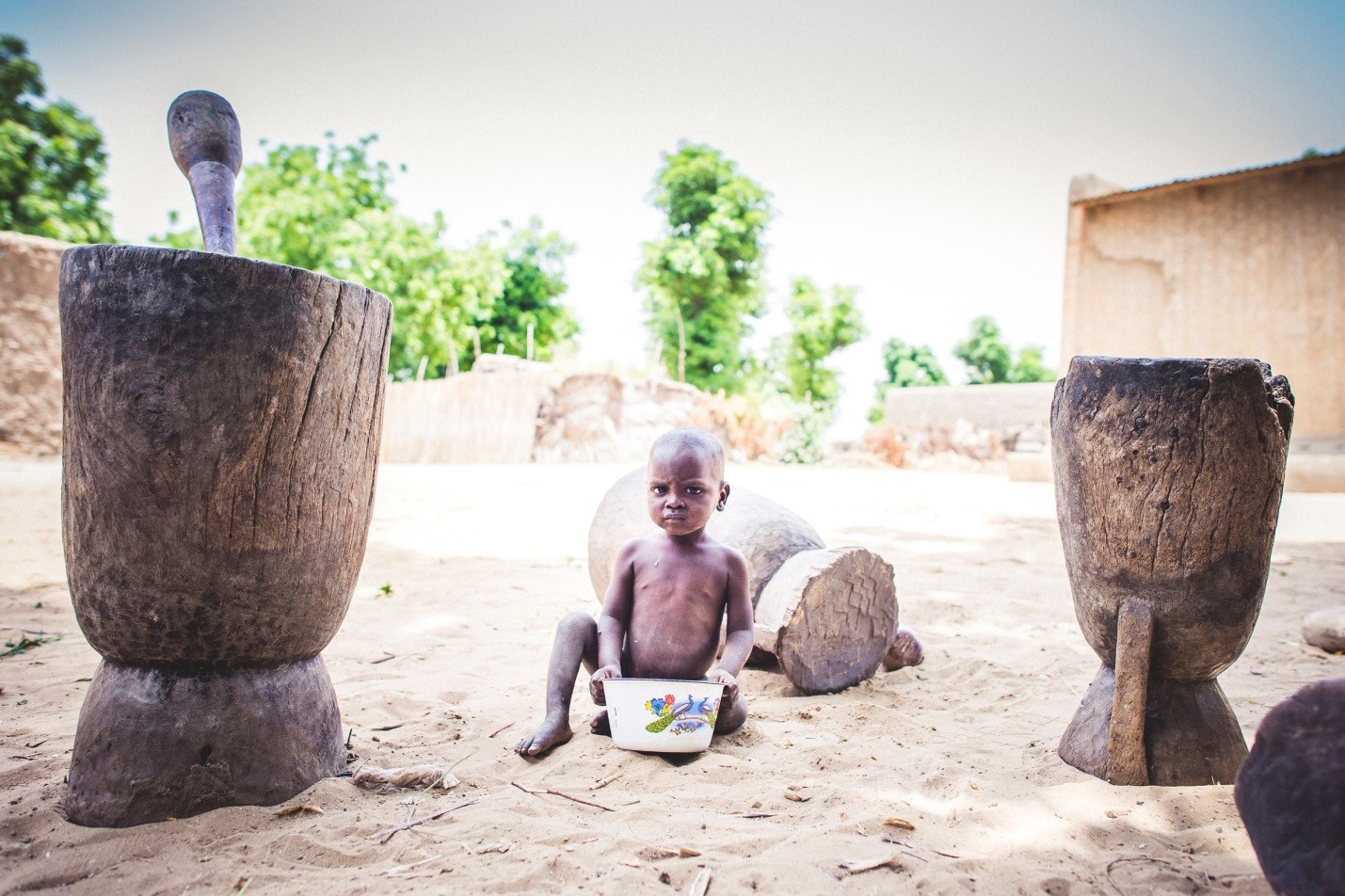
Child and calabashes: women grinding grains in calabash squash mortars and pestles make a rhythmic music. Copyright Sean Sheridan for Mercy Corps.
I and my Nigerien team from Mercy Corps, an international humanitarian and development organisation working in more than 40 countries, were there to discuss the potential of livestock and dairy production for generating income in the village. We needed to understand some of the challenges that would have to be overcome in the Filingué area for a thriving dairy business and nutrition programme to work. We quickly learned there were many.
The debates that flowed from this field visit in late 2014, and many to follow across the country, marked the start of an epic learning journey for our team and our partners in Niger. We had realised that we needed to rethink how we work to truly have enduring impact and help communities in Niger overcome the numerous threats they face in order to survive and thrive. Without injections of new thinking we risked treading the same worn path of “solutions” that, while they may improve food security for a time, proved inadequate in the long term. Their benefits, especially for families precariously teetering on the edge, would be short-lived the next time drought hit. What we needed to consider was resilience.
The big questions
Mercy Corps, founded in 1979, has responded to global emergencies in the past 20 years, providing relief and helping people recover from conflict or disaster. Our various programmes incorporate microfinance, market-systems development, food security, agriculture, health, conflict management and civil society strengthening. Recently, the organisation has made a deliberate shift, sparked by the growing pace and intensity of disasters and crises in today’s world and the recognition that – despite our industry’s collective efforts over the past few decades – the needs continue and are even growing in places where humanitarian and development aid has a long track record.
In 2013, we started building a new approach to the complexity defining the contexts where we work – our resilience approach. Mercy Corps has been refining its process over the past three years through field testing in our “Regional Resilience Hubs” in West and Central Africa, East and Southern Africa, and Southeast Asia.
We start by applying resilience thinking through what we call a Strategic Resilience Assessment (STRESS). This research and capacity-building methodology examines four key questions: resilience to what? Resilience of what? Resilience for whom? And resilience through what? Asking these core questions, together with local partners, helps us to produce a resilience-informed “theory of change” designed for a specific context. For two years, Mercy Corps has been developing, testing and refining the STRESS process, learning how to build a deeper understanding of resilience from contexts as varied as Nepal’s Far West and Midwestern regions to Uganda’s Karamoja and Acholi regions and, starting in August 2015, in Niger.
Understanding resilience, for us, was about making the uncertainty of tomorrow and the day after something we could grasp
Over the next ten months and beyond, our diverse team of Nigerien and international staff and partners embarked on a journey of learning and adopting this new way of thinking about our work that would take us to all seven regions of Niger, travelling over 20,000 kilometres (equivalent to halfway around the world) to speak with communities and consult local experts about the shocks and stresses facing them and the strategies they use to cope. It would guide us through understanding how economic, ecologic and social systems interact together in Niger’s 17-million-strong agropastoralist society to influence stable food availability, food access and proper nourishment.
We would dive into the reasons adolescent girls, for example, experience the impacts of rainfall variability differently than their brothers, mothers and fathers. We would define what resources and strategies would help Nigeriens better deal with shocks and stresses when they occur, better anticipate and change their conditions before the shock hits, and even transform the dynamics of the very systems that make them vulnerable in the first place. Finally, we would even begin to realise the barriers within our own team and country mission (and those in the wider development industry) that we must address if we hope to work together to translate resilience to collective action on the ground.
But first we had to ask the big questions. Months after that initial trip to the village outside Filingué, I met with our seasoned team back in the office in Niamey to begin to define and describe what problems most prevent communities in Niger from breaking out of decades of food insecurity. Those sights, sounds and smells from my first field visits came crisply to mind: the dust that dried and stuck in my nose, the hard rhythm of women working 16-hour days, the treasure of security represented by scattered sheep.
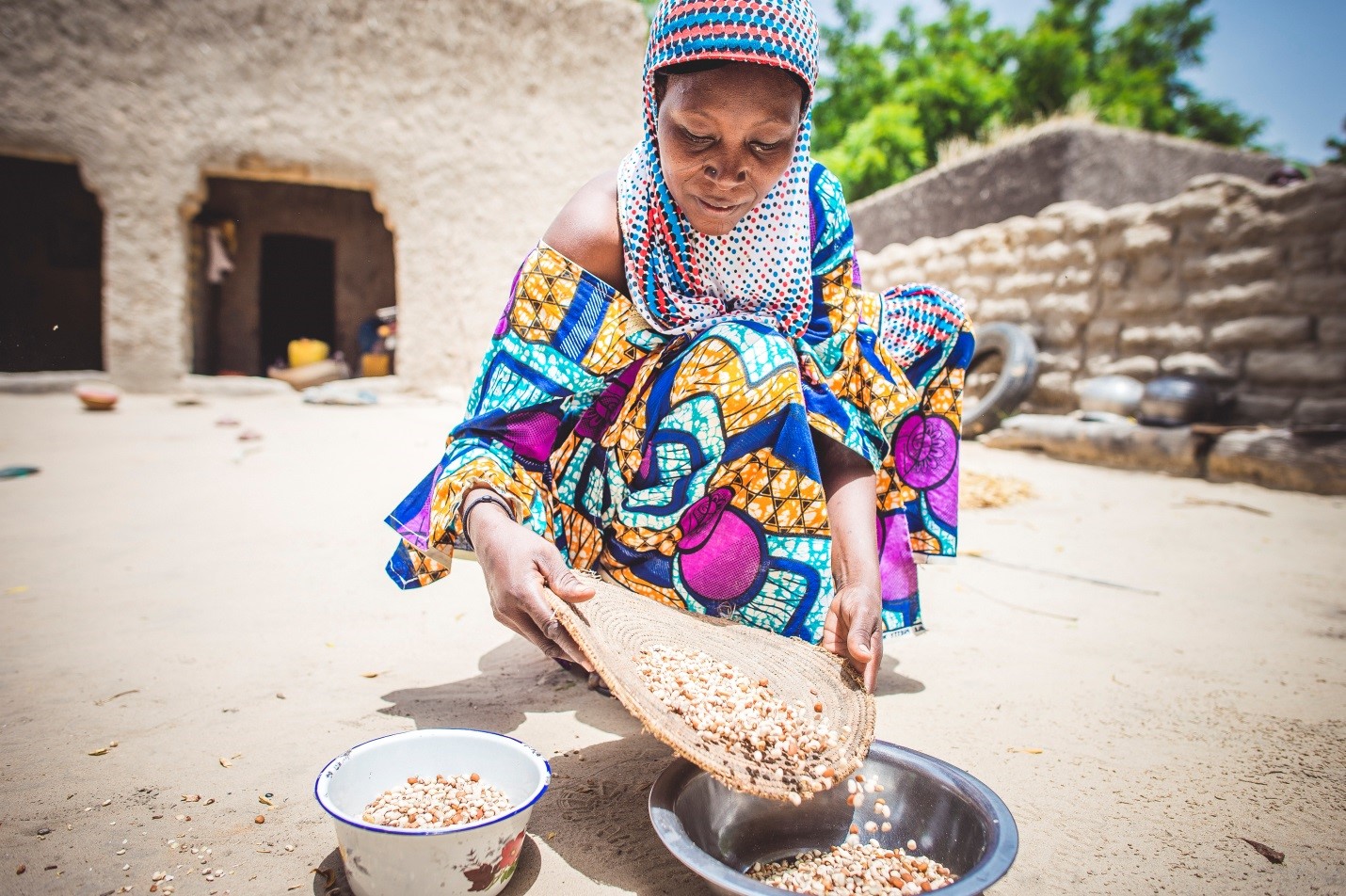
A woman from Niger’s Zinder region sorts grains. Severe droughts in the 1970s and 1980s shifted Nigeriens from traditional nomadic lifestyles to sedentary living supported by rain-fed agriculture. The amount of land under cultivation in Niger has tripled since 1960, but that is not enough to keep pace with the country’s 3.9% population growth rate, the world’s fastest. Copyright Sean Sheridan for Mercy Corps.
All of these sights and sounds – and what they represented – factored into the big questions we wanted to answer: what does it take to build resilience to cyclical drought, increasingly infertile lands, food price fluctuations and rising conflicts along Niger’s borders? How do these shocks and stresses relate to each other, and what makes their combination so overwhelmingly devastating for 83% of the population – roughly 14 million people – dependent on agropastoralism? What do communities need to understand their risks and meet them successfully? Understanding resilience, for us, was about making the uncertainty of tomorrow and the day after something we could grasp – to give us a compass to navigate complexity in the midst of a dynamic transition in Niger.
Confronting the big questions ahead meant we needed to combine diverse groups: our own staff, spread across several regions of the country in different offices, plus our peers and partners who could challenge our thinking and ground our shared learning in another level of contextual truth. We were joined by Mariama, a quiet but proud former shepherdess who grew up raising livestock in Niger’s Maradi region, now working on agriculture in our large food security programme and passionate about supporting women’s role in production. There was Tassiou – like Mariama, a skilled agriculturist – who strongly believes in the power of better cropping techniques for harnessing diminishing rainfall. And we welcomed Dr Koré Harouna, a professor at the Abdou Moumouni University of Niamey and an experienced agroeconomist eager to share stories from his years in public service. He had witnessed decades of small reforms to Niger’s economics and agricultural sectors.
Reading the signs
From August 2015 through January 2016, the team pored through dozens of secondary reports, interviewed over 30 experts from departmental to national levels and spoke with over 300 men, women and youth agropastoralists and pastoralists. Armed with information, we met many times with partners from local government and university, civil society and scientific research institutes, and regrouped a few times in structured workshops. During one of these pivotal gatherings – the “systems mapping” workshop – we encouraged each other to step out of our specialist roles as “nutritionist”, “livestock advisor” or “market analyst” to map the context in Niger.
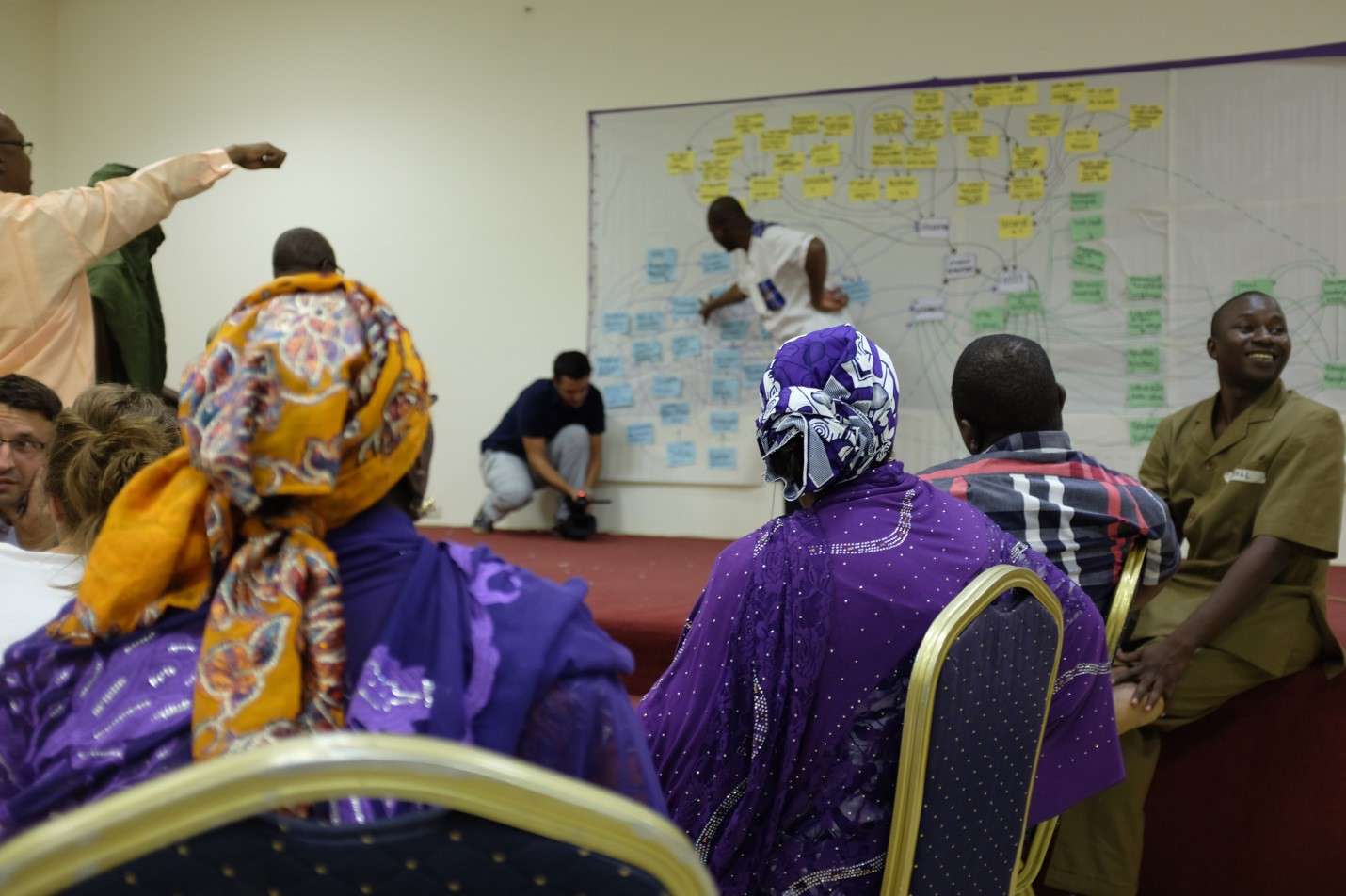
A 2015 workshop helped Mercy Corps map the vast, complex web of interconnected systems and risks in Niger. That web is influenced by changing trends in demographics, the unforgiving pace of climate change, deep-rooted social attitudes and intricate coping strategies built over generations. Copyright Sanjay Gurung for Mercy Corps.
What we learned surprised us. It wasn’t merely how a single shock affects the delicate interconnections between systems, but rather how Niger’s multiple shocks and stresses interact together and often at different scales simultaneously – within households, at the landscape level, along borders – which degrades communities’ ability to get ahead and stay on track. Development constraints like inadequate infrastructure and a soaring population intensify impacts. We learned that the shocks and stresses that bear the greatest risk for rural agropastoralist and pastoralist families are those that directly affect food production. And while many of these start as climatic or environmental stresses – such as erratic rainfall, drought or loss of viable farm and pasturelands – their ripple effects have economic and social impacts.
We found one particularly “wicked” feedback loop that reinforces vulnerability between climatic shocks and reproductive practices among rural agropastoralists. Families unable to overcome repeated shocks to their food production face continued uncertainty. Season to season, this uncertainty and stress on household production contributes to and helps perpetuate the social norm of early marriage, driving the world’s highest rates for girls married before age 15 (nearly 1 out of 3) and age 18 (3 out of 4). Once an adolescent girl is married, she will start having children almost immediately – before her body is biologically ready – and usually without adequate nutrition and maternal services to ensure a healthy pregnancy or healthy baby.
In 2011, analysis by the World Health Organisation showed that young mothers are at higher risk during pregnancy and giving birth, and that children born to mothers younger than 20 years old are more likely to have problems, including delayed development and health problems that persist later in life.1 1. World Health Organization, 2011. Preventing early pregnancy and poor reproductive outcomes among adolescents in developing countries: WHO guidelines. 195 pp. ISBN: 978 92 4 150221 4. WHO Download site See all references Data show that Nigerien women have a child every two years, up to an average of eight children per woman – and this in turn drives increasing pressure on land resources and risky dependence on agriculture and fluctuating markets, and so the cycle of vulnerability continues.
Our work established one of the ways that erratic rainfall patterns and drought cycles affect adolescent girls in Niger differently than their family members. Furthermore, those hidden links affect long-term food security in ways we could not see immediately without asking questions about resilience. What did this finding mean to our team? On a very simple level, it meant that our efforts to target adolescent girls and their future husbands with nutrition and reproductive messaging and services are important for food security.
But it’s only one part of a complex picture. Our strategies for supporting development and food security need to look in a more integrated way at diminishing land access, reduced soil fertility, dependence on rain-fed agriculture, entrenched gender inequity, early marriage and chronic malnutrition – and then they need to go a step further to understand these dynamics in a context of more frequent ecological and climate shocks. On a different level, it also meant that programmatic operations divided into segregated units – an agriculture team, a gender team, an NGO, a ministry department – with a promise to “cross-fertilise” and “coordinate better”, would also have to shift.
We began to understand that we needed to break out of our typical frames of reference, a realisation that became a defining feature of the team’s learning. For Tassiou, as he travelled for the first time to the southeast corner of the country to oversee primary data collection in the Diffa region, he was alarmed to find Nigeria’s Boko Haram conflict had seeped across the border and threatened both the social fabric of the communities as well as the traditional seasonal movements of young men with their livestock. He found a stark conservatism that called into question the Niger he knew, and realised that achieving gender equality would be an even steeper uphill battle in this isolated corner of the country.

A map of Niger’s seven regions. Effects of conflict with Boko Haram at the border with Nigeria (marked in orange) have spilled into Niger. Illustration: Elsa Wikander/Azote.
Faced with landscape-level data, the usually contemplative Professor Harouna became a passionate speaker in our arguments around the prospects of rain-fed agriculture to keep pace with the burgeoning population growth rate. He argued that more than just the data is important: “I think that the strength of the approach used during this process is the sharing of experiences and knowledge by local actors and those of diverse backgrounds.”
Mariama surfaced after five intense days wrestling with resilience concepts in a workshop, with her understanding changed. She “thought [she] knew before what resilience was,” but now she saw that it was “how all of the systems fit together” and how her agriculture work is intricately connected to a larger system and needs to bolster communities’ abilities to deal with shocks and stresses.
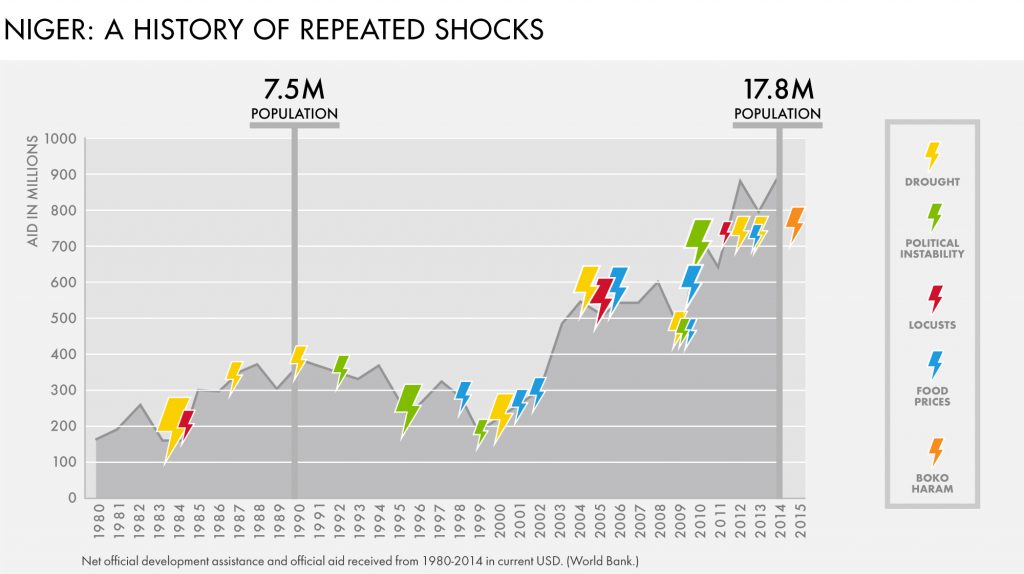
Resilience requires an understanding of the dynamic relationships between shocks and stresses and how they play out with other developmental trends. Threats from violence from Boko Haram across the border in Nigeria are one of the newest shocks to interact with socioeconomic challenges in Niger, atop trends of population growth, cultural shifts, and underlying environmental conditions. Aid to Niger has nearly tripled since 1990. Data from the World Bank and Mercy Corps; copyright Mercy Corps (references 3, 4).
A changed horizon
Resilience thinking is pushing Mercy Corps to evolve our work all over the globe. Niger is one example that has highlighted for our global organisation why resilience is critical to our mission – not only as humanitarians, but as connected communities in a very complex world. We are applying the STRESS processes currently in Mongolia, Ethiopia, Democratic Republic of Congo and this year we have plans for northeastern Nigeria as well.
Even though the Niger team completed its Strategic Resilience Assessment, the learning process has only just begun.2 2. Mercy Corps, 2016. Niger Strategic Resilience Assessment. 59 pp. Mercy Corps Download site See all references There is still a lot that we don’t know and continue to research, but now we can start to test what we think will work for communities in Niger to absorb and adapt to changing conditions, in order to make sustained progress towards food security. Our team and local partners in Niger realised that resilience isn’t solved in ten months and neatly wrapped up in a pretty report. It’s bigger than that – and it’s shifting the way we work, from calling into question the way we co-design long-term development strategies to improving how we hire and cultivate “systems thinkers” to empower local action.
Changing the way we think and work to embrace resilience and complex systems thinking is not an easy mission to accept in an industry that clings to linear logical models, siloed funding streams and reporting impacts within short project timeframes. Committing to resilience as the approach that supports how we tackle the world’s development challenges upends a lot of the rules we set for traditional development. But in Niger we’re starting to crack through the glass walls: it started with a commitment to learn together as diverse partners, who are now poised to influence the agenda for change.
By accepting that resilience is a long-term learning process – which requires us not only to adjust our projects but to reshape the system – our team has come to know that working little by little to understand complexity can make the difference in strengthening food security outcomes for millions of Nigeriens. As we progressed, we waded deeper and deeper into questioning some of the fundamental things our team thought non-negotiable. Through a process of learning, made powerful because it was led by our team and partners, we arrived at the conclusion that resilience is different, it does demand more of us, and it’s never been more pressing for the communities with whom we partner.
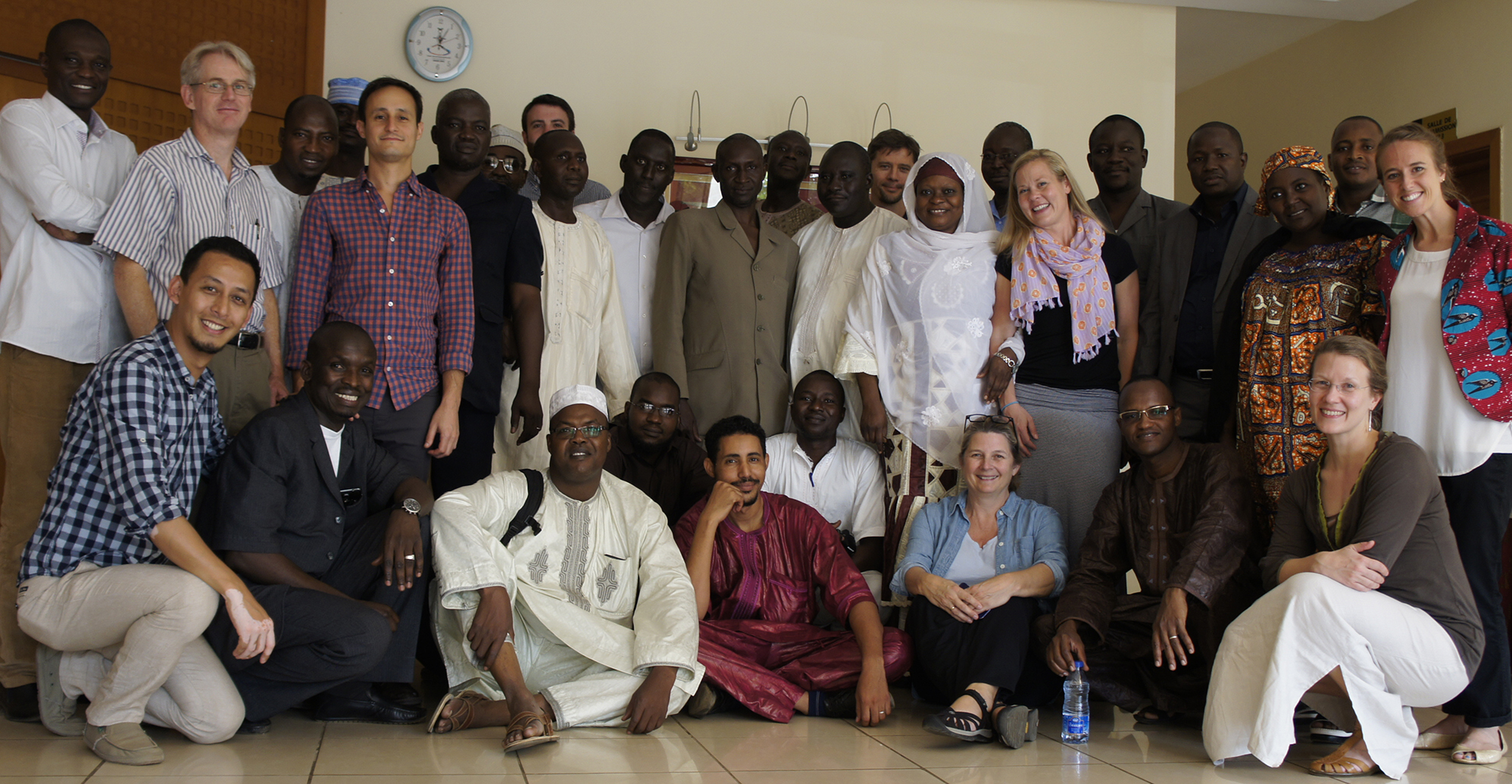
The Mercy Corps team in Niger: staff, peers and partners who could challenge preconceived thinking, to get to resilience thinking. Danielle Jolicouer is far right. Copyright Sanjay Gurung for Mercy Corps.

 12 MIN READ / 2513 WORDS
12 MIN READ / 2513 WORDS